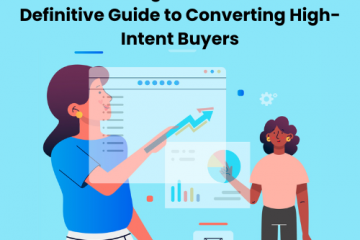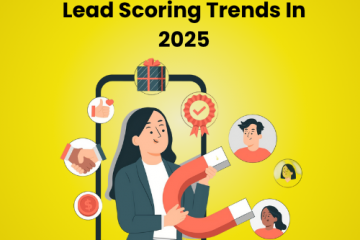Buyer Intent Data in 2025: Definition, Types, Strategies & Best Providers
Generating quality leads is still considered the biggest challenge among marketers. In fact, over 80% of new leads never convert into sales. Prospects may love your product but may not be ready to buy, or buyers in the market today probably haven’t booked a meeting with you.
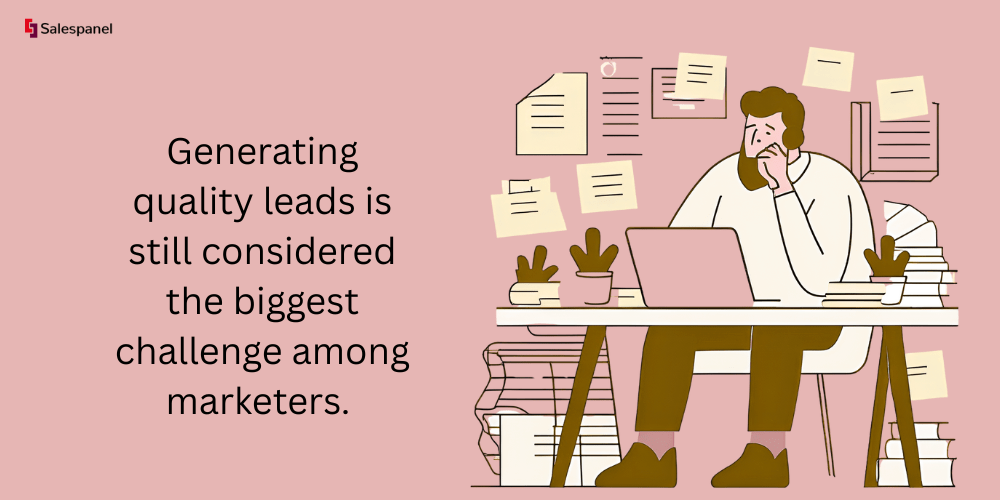
Imagine getting access to such data before launching your marketing campaigns. Instead of casting your net wide for prospects, you would target accounts looking for the exact solutions you offer, thus connecting with ready-to-purchase buyers and making conversions easy-peasy!
This is what buyer intent data is about—detailed insights that tell you which companies are actively searching for the products you are selling.
B2B intent data sheds light on the buying signals that businesses exhibit when they proceed through the buyer’s journey. These signals may include frequent visits to your website or multiple accounts from the same company interacting with your social media ad. This data can help GTM experts target in-market accounts more effectively for sales.
Do you want to know more about buyer intent data and how to leverage it to fill your sales pipeline with high-intent leads that are ready to convert?
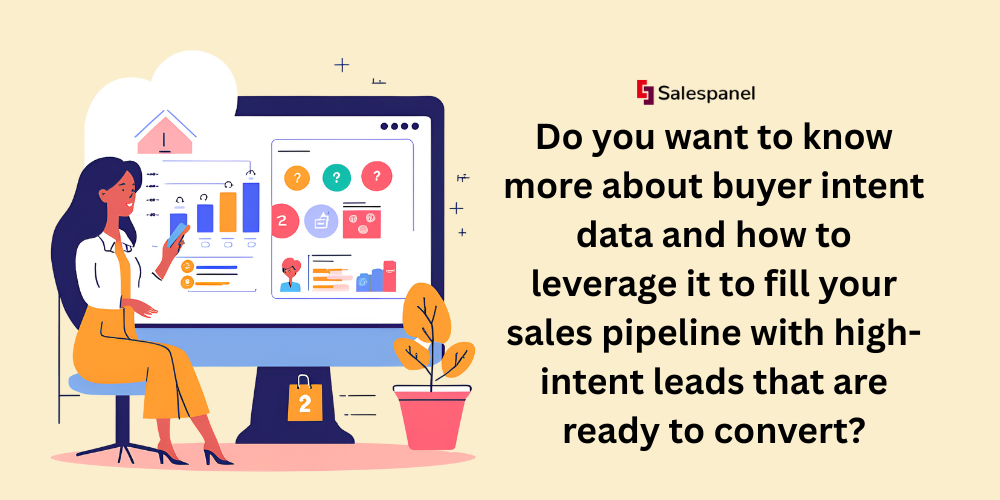
In this blog, we will discuss everything you need to know about buyer intent data, including its types and benefits, how you can use it to power your sales and marketing initiatives, the tools you can use to collect intent data, and the challenges you may face in using the insights, plus some best practices you can follow to overcome them.
What is Buyer Intent Data?
Buyer intent data is a measurable set of cues indicating whether a potential customer is interested in or ready to buy a product from your company.

Image Source: Learn.g2.com
In simple words, it is sales intelligence that demonstrates the kind of content the lead is consuming and the behaviors they exhibit thereafter. Buyer intent data provides insights that allow a business to know which leads are ready for the buying process so that the latter can prioritize them. Here are some examples:

- Website Activity: Pages visited (product pages, pricing pages, case studies), time spent on specific pages, and frequency of return visits to the website
- Search Behaviour: Keywords searched (e.g., best CRM software) and the frequency of use of commercial intent keywords like “buy”, “price”, or “discount”
- Content Engagement: Downloads of white papers or eBooks, sign-ups for product demos or webinars, and engagements on blog posts or FAQ sections
- Form Submissions: Contact form submissions, quote requests, or free trial sign-ups
- Third-Party Data: Review site visits to G2, Capterra, and Trustpilot and competitor research on industry-related topics
Insights like these can enable any company to pursue prospects who are actively engaged, which increases the likelihood of conversion and generates greater revenue from the pipeline. By leveraging these insights, the sales and marketing teams will then be able to prioritise in-market accounts that demonstrate active research in relevant subjects.
Why is Buyer Intent Data Important?
Understanding the interests and behaviors of prospective customers can help maximize further sales and marketing initiatives. Here are some other reasons why buyer intent data is important:
- Improved Targeting: Buyer intent data helps businesses identify prospects actively showing interest in their offerings, leading to far superior marketing campaigns.
- Quality Leads: By focusing on prospects with clearer buying signals, companies can prioritize leads with a better chance of converting, boosting sales success rates.
- Personalized Outreach: Insights on customer preferences allow companies to create tailored messages that truly resonate, furthering customer engagement.
- Competitive Advantage: Buyer intent data provides in-depth insights into emerging market trends, enabling businesses to obtain a competitive edge.
- Shorter Sales Cycle: Recognizing in-market accounts already interested in a product allows companies to sell to them much faster, speeding up conversions.
- Informed Decision Making: Buyer intent data fosters well-informed decisions in product development, marketing, and resource allocation that sustains business growth.
- Boost Business ROI: Intent data can help businesses boost ROI by investing their resources into only high-intent leads, cutting down on overall customer acquisition costs.
Want your business to make more money working smarter rather than harder? Buyer intent data is the solution.
But what do we really mean by buyer intent data? We did discuss some examples in the previous section above, so let’s expand a little more on different types of B2B intent data.
Types of Buyer Intent Data
Buyer intent data can be primarily subdivided into two categories: first-party data and third-party data.
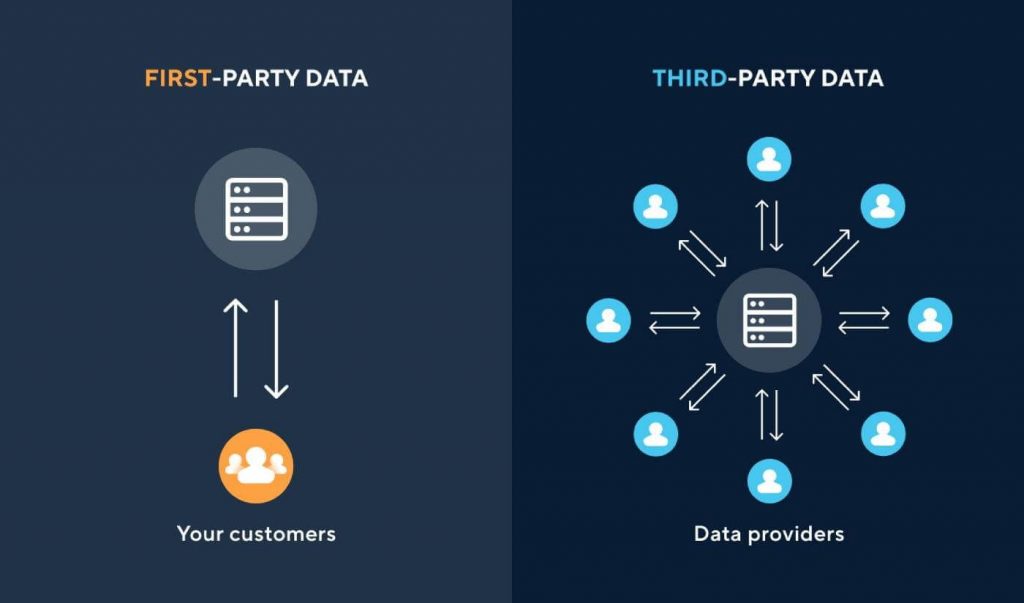
Image Source: Intercomassets.com
First-Party Intent Data
First-party data is the information collected from your audience or customers directly from their interactions with your brand, including, among other things, website visits, email performance (opens, clicks), customer relationships, and customer surveys
First-party data is more accurate and respectful of user privacy. It originates from actual user behaviors attributable to an audience that embraces approved content privacy regulations. Using this data, companies can build personalized marketing solutions for their audience by leveraging preferences, thus maximizing user engagement and improving conversion rates.
Third-Party Intent Data
Third-party intent data is related to signals observed and documented by external sources. These sources track users across many platforms, providing insight into buyers’ interests. It includes browsing history, search queries, and engagement metrics on third-party sites.
Third-party data helps businesses identify leads they may not be able to reach otherwise, find emerging market trends, and conduct competitive analysis. If companies capitalize on this type of data, their targeting efforts can be better focused on prospects actively researching related products or services, thus increasing the chances of conversion and overall marketing success.
First-party and third-party data can be further classified into known and anonymous intent data.
Known intent data consists of information visitors voluntarily provide while filling out forms on a company’s website. Conversely, anonymous intent data is information collected via tracking visitors’ IP addresses as they navigate different websites and geo-tagging the corresponding companies with which the accounts are associated.
The only difference is that the source website itself collects first-party data, while third-party data is collected by external intent providers that pass it to the parent company for a fee.
Types of Buyer Intent Data Sources
Do you know where to find buyer intent data?
A range of sources can be used to extract buyer intent data sets, including search intent, engagement, firmographics, and technographics, in B2B markets.
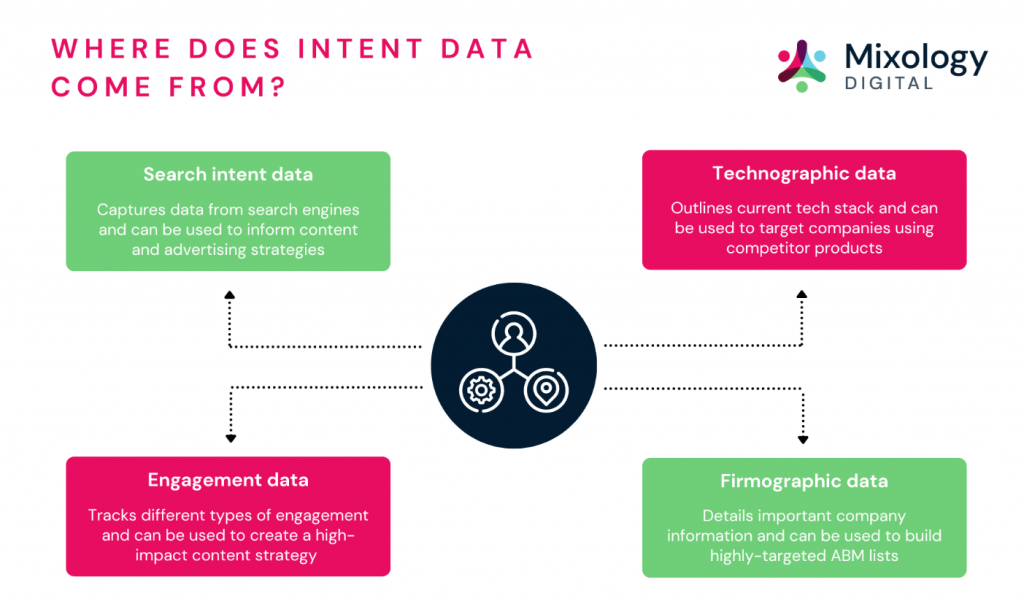
Image Source: Mixology-digital.com
Search Intent Data
Search intent data defines online queries based on what users are searching for. It allows businesses to decipher the goals behind a search behaviour, whether it is researching, comparing, or buying. It will often enable companies to align their content strategy with users’ needs and increase conversion rates.
Example: Someone searching for “best CRM software for small business” shows that they may be serious about making a purchase.
Engagement Data
Engagement data reveals how users engage with a brand’s content, such as website visits, email clicks, or social media activity. Through these metrics, businesses may discover what people are responding to, so they can develop a more personal approach to their marketing campaigns. Increased engagement in most cases translates into a greater prospect of buying intent, allowing the identification of those with higher buyer intent.
Example: A lead going to your pricing page more than once or downloading your product guide would indicate serious interest.
Firmographic Data
Firmographic data describes the most defining characteristics of organizations, such as company size, industry, revenue, and location. Thus, a company can target marketing and sales efforts toward segments similar to its ideal customer profile, boosting marketing effectiveness.
Example: Targeting mid-sized tech companies in a specific area with a subscription-based SaaS product or service.
Technographic Data
Technographic data describes the tech tools and systems companies use, including hardware, software, and IT infrastructure. This gives organizations insights into the technological environment, allowing businesses to shape their marketing strategy as they align their solution with the prospect’s tech stack, thus improving engagement and conversion likelihood.
Example: Identifying a company using a competitor’s product may easily indicate upselling or cross-selling opportunities.
Now that you have an understanding of B2B buyer intent data, including its types and benefits, let’s check out how you can use buyer intent data to power your sales and marketing efforts.
How to Use Buyer Intent Data in B2B Sales and Marketing Efforts?
Buyer Intent Data in B2B Sales
Here are a few ways that buyer intent data can be used in B2B sales:
1. Identify High-Intent Leads
Did you know that poor data quality costs organisations worldwide $12.9 million every year? Buyer intent data can help you save that amount by spotting prospects actively researching solutions, indicating a high intent to purchase. Online behavior analyses, including website visits, content downloads, and competitor comparisons, can give businesses insights into leads most likely to convert. This helps sales teams zero in on the most promising opportunities, increasing efficiency and conversion rates.
2. Timely Outreach
Engaging prospects at the right moment makes all the difference in outreach, allowing you to improve conversion chances greatly. Buyer intent data signals when a lead has progressed to the decision-making stage, enabling a proactive response from the sales team. With keenly timed outreach, companies can offer the right solution when interest is at its height, improving engagement and closing rates.
3. Leverage Multi-Channel Strategies
Did you know that it can take eight or more touchpoints to convert a prospect into a customer? Buyer intent data feeds a personalised, multi-channel sales approach. Sales teams can tailor outreach by knowing where a prospect engages the most—email, social media, or webinars. Messaging that aligns with buyer behaviour across multiple channels creates a consistent experience, which means greater engagement and higher conversions.
4. Cold Calling Context
A cold call is not a blind date in 2025. Know what your target prospects need, and whether your solutions can fill those pain points before you ever ring a ding on their number. Buyer intent data can do that trick, making your cold calls more meaningful. Rather than generic pitches, salespeople can reference a prospect’s recent searches, downloaded content, or industry interests, allowing for a more tailored conversation. This signals a deeper understanding of the prospect’s needs, thus increasing engagement and trust.
5. Reduce Churn and Improve Upsell
Buyer intent data helps pinpoint the at-risk customers contemplating competitors’ solutions. Tracking these behavioural cues allows companies to take the initiative in addressing concerns and providing better assistance to clients, thereby minimising churn. Additionally, this data helps companies identify new features customers seek in competitive products and shape product development accordingly, thereby creating relevant upsell opportunities. This allows businesses to maximise revenues from existing clients.
Buyer Intent Data in B2B Marketing
Here are a few ways buyer intent data can be used in B2B marketing:
1. Improve Audience Targeting
Did you know that 56% of businesses use buyer intent data to recognise and target new accounts? Buyer intent data assists marketers in precisely focusing their targeting by identifying prospects performing the search for solutions that match what they are offering. Marketers can use this information to direct their engagement toward high-intention prospects instead of targeting wide demographics. This gives companies the opportunity to connect with accounts actively sending out buying signals, fostering higher engagement and conversion rates while decreasing the loss of ad spend.
2. Build ABM Campaigns
For some time now, account-based marketing campaigns have targeted specific high-value accounts, with buyer intent data elevating this to another level. Say you saw two people from Salesforce download your website’s employee onboarding trend report. This enables your marketing team to tailor an eBook on best practices for employee onboarding, specifically for employees working at Salesforce. Neat, right? Thus, buyer intent data can enable marketers to deploy highly personalised campaigns addressing target accounts, providing relevant content and solutions to enhance engagement and improving conversion rates at the buyer journey stage.
3. Personalise Marketing Messaging
Did you know 72% of consumers today engage exclusively with personalised marketing messages? This is where buyer intent data plays a crucial role. By analysing buyer intent signals, marketers can create messages specific to each prospect’s needs and pain points. Dynamic content, targeted advertisements, and customised email sequences ensure that marketing actions resonate with potential buyers, promoting greater interaction and conversion rates.
4. Optimise Content Strategy
Published a brand new whitepaper? Nice! With buyer intent data, you can get it in front of the right prospects—those interested in your product. Marketers can analyse potential buyers’ intent factors to identify the topics that capture and retain their attention. For example, high-intent buyers may not engage with many blogs, but packaging the same content into an eBook might give you traction! Comparing your blog’s page views to your eBook’s downloads allows you to infer the type of content drawing in more views. This will guide companies in properly optimising their content strategy to create assets that fit what the audience wants and attract and nurture high-intent leads throughout their buying journey.
5. Ensure Alignment with Sales
Buyer intent data helps bridge the divide between sales and marketing by offering instant insights into how prospects behave. Tracking these purchase signals means marketers send only high-intent leads to sales reps. With buyer intent data, you also have helpful contextual insights about the leads marketing is passing to sales. This allows sales to engage prospects in a timely and highly relevant manner, creating a unified buying experience and raising the likelihood of closing deals. Buyer intent data is powerful, isn’t it? So, how do you collect this data? In the following section, we have highlighted the top five buyer intent data providers of 2025.
How to Collect Buyer Intent Data: Top Five Buyer Intent Data Providers of 2025
Here are the top five buyer intent data providers of 2025:
1. Salespanel
Salespanel is our product, and while we are biased toward it (understandably), it is one of the best products on the market for helping businesses identify anonymous, high-intent accounts visiting their websites. The software analyzes how visitors and leads engage with your content, including blog posts, case studies, webinars, and emails.
By tracking real-time website activity, analyzing a combination of behavioral signals, and mapping them to specific companies, Salespanel provides valuable insights into businesses actively researching solutions similar to your offerings. Using this software, companies can qualify leads and personalize the buying experience, increasing the chances of conversion.
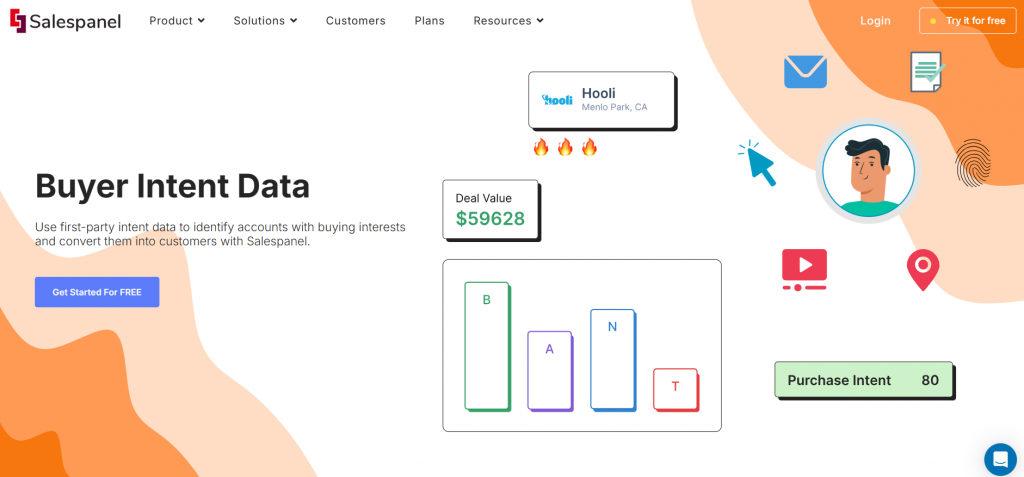
Key Features:
- Real-time intent tracking by monitoring page views, time spent, and content downloads
- Anonymous visitor mapping for company identification
- Real-time alerts for sales reps indicating high-intent activities to promote timely outreach
2. 6sense
6sense is a powerful account engagement platform that leverages AI-driven intent signals to help B2B teams identify in-market accounts, prioritize outreach, and drive revenue. It tracks buyer behavior across multiple touchpoints—including search, website visits, and third-party sources—to uncover hidden demand and predict purchase readiness with high accuracy.
6sense enables marketing and sales teams to engage prospects earlier in the buying journey by revealing anonymous buyers and surfacing accounts that are showing strong intent signals. With its predictive analytics and full-funnel visibility, teams can run targeted campaigns, reduce wasted effort, and align around the most valuable opportunities.
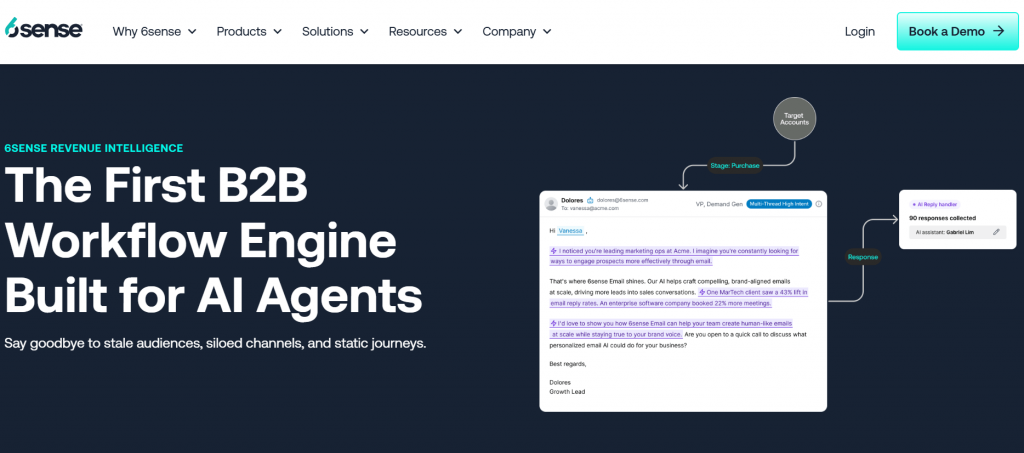
Key Features:
- AI-powered predictive insights to uncover and prioritize in-market accounts
- Aggregates intent data from multiple sources including web, search, and partner networks
- Deep account and contact-level insights to fuel personalized outreach
- Integrates seamlessly with CRMs and marketing automation platforms for unified GTM execution
3. ZoomInfo
ZoomInfo is a go-to-market solution empowering businesses to pinpoint and engage with leads that display highly active buying behaviors. The platform combines a vast database of company and contact information with real-time B2B intent data signals.
This kind of precision targeting allows ZoomInfo to provide strategic sales engagement options for high-potential leads and, therefore, a greater level of personalization in their engagement, enhancing sales strategies and improving the likelihood of conversions.
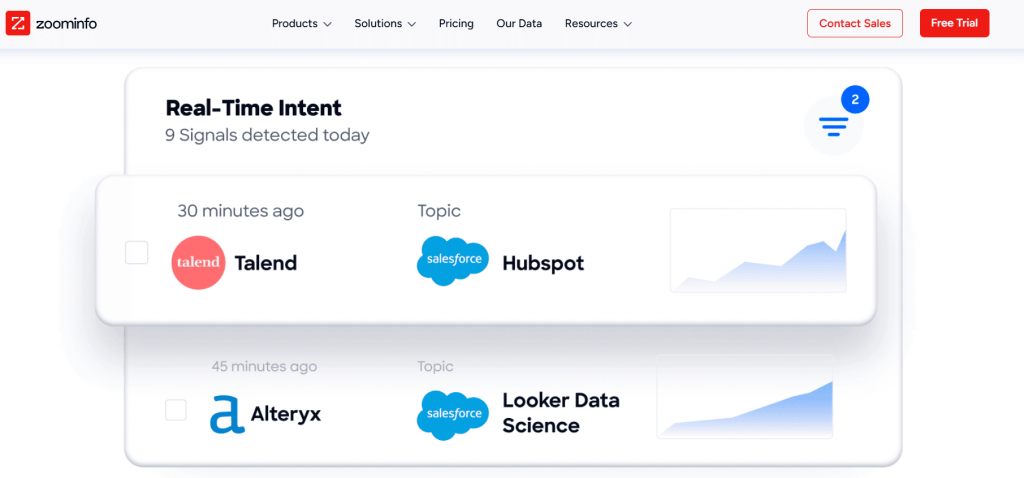
Key Features:
- Automated workflows and filters for segmentation
- Live B2B intents data signals
- Simple integration with various CRM and marketing automation tools
4. Bombora
Bombora is one of the leading companies providing B2B intent data to businesses to help them better align marketing and sales teams. Bombora offers valuable insights on businesses currently in the market actively researching specific topics. This equips organizations to prioritize target accounts, tailor their outreach, and optimize their marketing efforts.
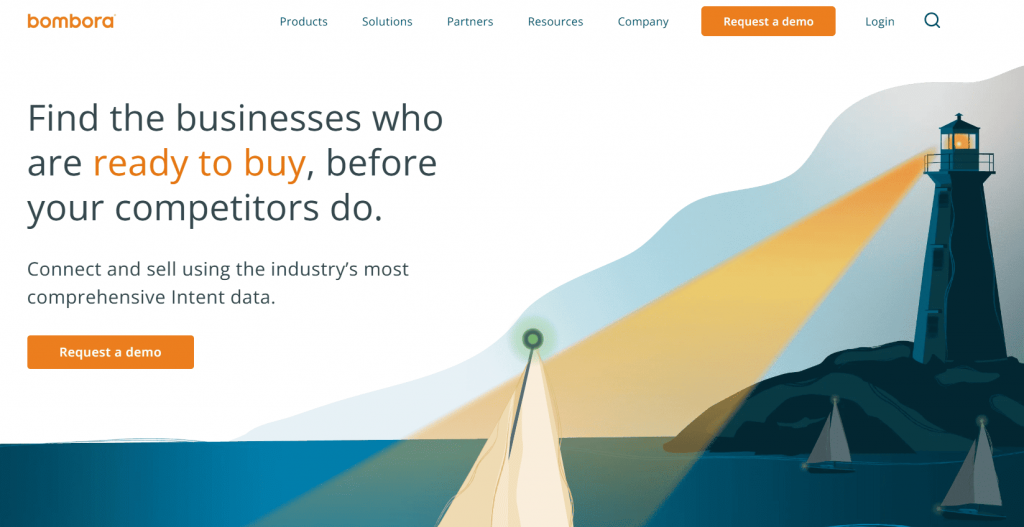
Key Features:
- Combines audience segments and proprietary first-party data with selected media activation partners to ensure consistent execution of ABM programs
- Identifies the current demand for products and services by analyzing content consumption activities of millions of B2B enterprises
- Extract insights from data recorded by millions of organizations about the composition and engagement patterns of audiences for ad creatives, website visits, or landing pages.
5. Leadfeeder
Leadfeeder is a great B2B intent-based data tool for small and medium-sized businesses. It analyzes buyers’ data from online visitor analysis and finds out which companies show interest in the product, even if they don’t fill out a form or connect directly. In turn, this helps lead scoring by sales and marketing to prioritize leads with higher intent, resulting in better engagement.
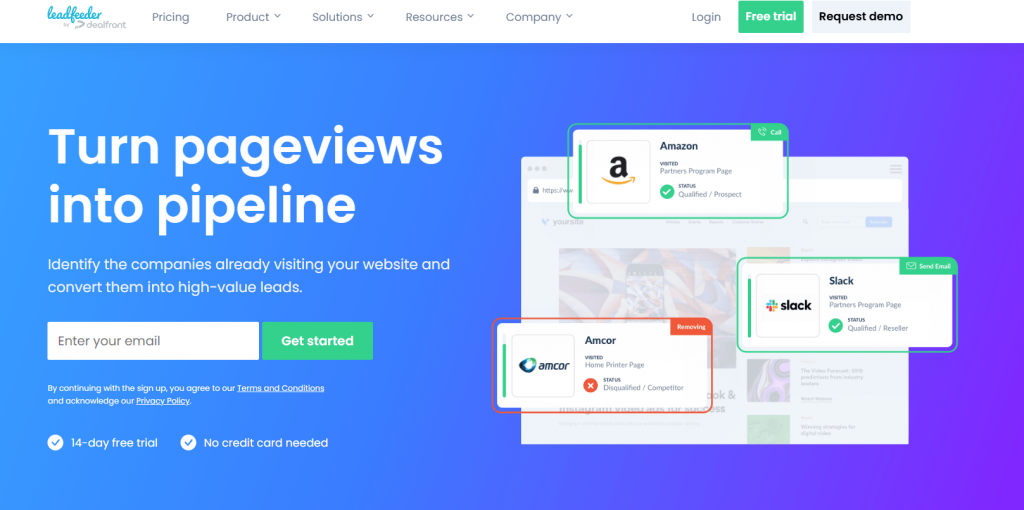
Key Features:
- Visitor identification of company accounts, behavior tracking, and scoring of leads, helping sellers in focusing on high-value prospects
- Customizable filters to separate leads by location, industry, company size, or a specific page visited for targeted leads
- Seamless integration of visitor data with your CRM and marketing tool, with your workflows, enabling your sales team to jump on warm leads immediately
6. G2 Market Intelligence
G2 Market Intelligence draws insights from the G2 platform data to highlight and provide software companies with crucial insights relevant to their niche and other business dynamics.
G2 Market Intelligence provides marketers with instant insights using real-time customer data to answer complex market positioning questions such as customer satisfaction, perceived pricing levels, and win/loss statistics for their products and those of competitors. It allows GTM teams to draw influential insights into actual buying behavior plus sentiments within their target markets.
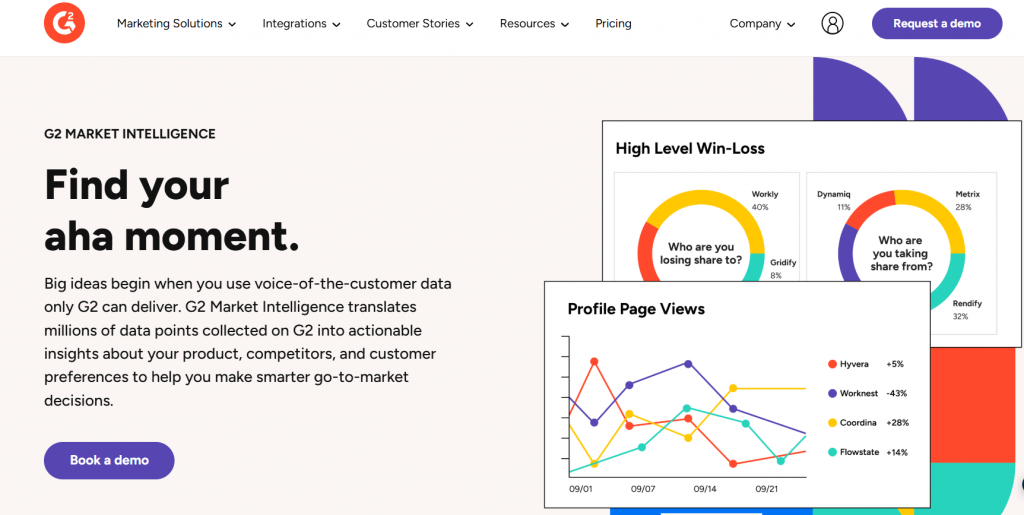
Key Features:
- Exclusive access to voice-of-customer insights and trends
- Competitor analysis and market positioning intelligence
- Perceptions about pricing and discounting for making well-informed decisions
Challenges and Best Practices of Using Buyer Intent Data
Buyer intent data can be helpful. However, that doesn’t mean that there aren’t challenges of using such insights to complement your sales and marketing initiatives.
To avoid any pitfalls, please be aware of the following challenges (don’t worry, we have provided some solutions to overcome these shortcomings, too!):
Irrelevant and Inaccurate Data Points
Databases of buyer intent aren’t always trustworthy—some signals can be false or outdated, wasting all marketing efforts.
Solution: Work with reputable data providers who regularly clean or update your data. Combine intent information with firmographics and behavioral insights for a more comprehensive perspective. Using other resources to corroborate or cross-verify data helps assess its accuracy.
Lack of Visibility
Many companies struggle to understand which source generated more accurate intent signals, making it difficult to trust and act on the insights.
Solution: Support integrated platforms that aggregate data from multiple intent data sources, leverage state-of-the-art analytic tools with clear reporting and dashboards that report insights on behavioral signals, and collaborate closely with sales teams to validate lead engagement.
Ethics and Data Privacy Concerns
Gathering and implementing intent data in compliance with privacy regulations such as the GDPR might be challenging.
Solution: Ensure compliance with laws that govern data privacy. Obtain user consent and anonymize data as much as possible. Be transparent about data collection practices and build rapport with prospects and customers by prioritizing the ethical use of information.
Leverage Buyer Intent Data to Drive B2B Sales and Marketing Growth
Buyer intent data is a game-changer for B2B businesses, unlocking new opportunities for building strong customer relationships, which can drive B2B sales and marketing growth.
Harnessing first-party and third-party intent data can help companies score and prioritize the leads signalling the greatest intent, personalize outreach, and optimize marketing and sales strategies for greater conversions. We hope the strategies and providers highlighted in this blog help you collect and activate intent data to its fullest potential. You must also address challenges like inaccurate data, lack of data visibility, and privacy concerns. Work smarter, not harder.
Are you ready to take your sales pipeline to the next level? Leverage buyer intent data with Salespanel to identify accounts with buying interests and convert them into customers today.
Sell more, understand your customers’ journey for free!
Sales and Marketing teams spend millions of dollars to bring visitors to your website. But do you track your customer’s journey? Do you know who buys and why?
Around 8% of your website traffic will sign up on your lead forms. What happens to the other 92% of your traffic? Can you identify your visiting accounts? Can you engage and retarget your qualified visitors even if they are not identified?
